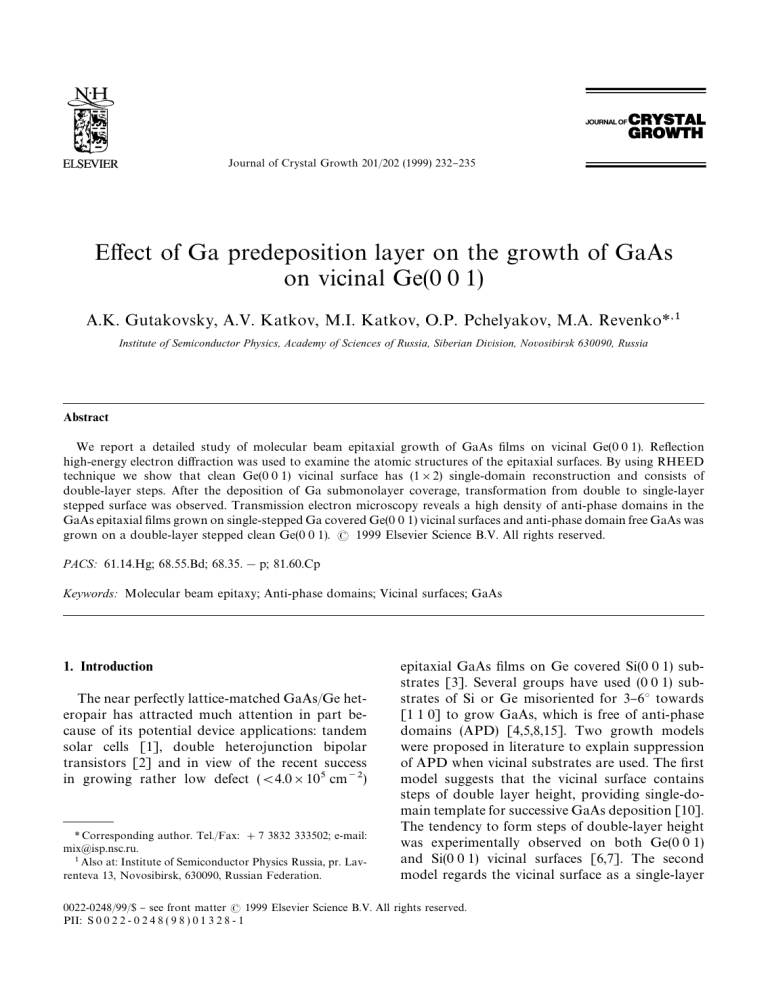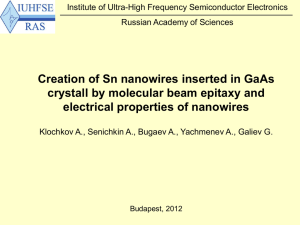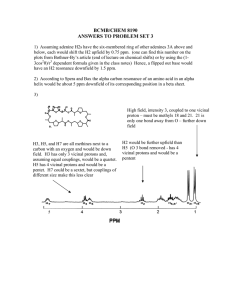
Journal of Crystal Growth 201/202 (1999) 232}235
E!ect of Ga predeposition layer on the growth of GaAs
on vicinal Ge(0 0 1)
A.K. Gutakovsky, A.V. Katkov, M.I. Katkov, O.P. Pchelyakov, M.A. Revenko* Institute of Semiconductor Physics, Academy of Sciences of Russia, Siberian Division, Novosibirsk 630090, Russia
Abstract
We report a detailed study of molecular beam epitaxial growth of GaAs "lms on vicinal Ge(0 0 1). Re#ection
high-energy electron di!raction was used to examine the atomic structures of the epitaxial surfaces. By using RHEED
technique we show that clean Ge(0 0 1) vicinal surface has (1;2) single-domain reconstruction and consists of
double-layer steps. After the deposition of Ga submonolayer coverage, transformation from double to single-layer
stepped surface was observed. Transmission electron microscopy reveals a high density of anti-phase domains in the
GaAs epitaxial "lms grown on single-stepped Ga covered Ge(0 0 1) vicinal surfaces and anti-phase domain free GaAs was
grown on a double-layer stepped clean Ge(0 0 1). 1999 Elsevier Science B.V. All rights reserved.
PACS: 61.14.Hg; 68.55.Bd; 68.35.!p; 81.60.Cp
Keywords: Molecular beam epitaxy; Anti-phase domains; Vicinal surfaces; GaAs
1. Introduction
The near perfectly lattice-matched GaAs/Ge heteropair has attracted much attention in part because of its potential device applications: tandem
solar cells [1], double heterojunction bipolar
transistors [2] and in view of the recent success
in growing rather low defect ((4.0;10 cm\)
* Corresponding author. Tel./Fax: #7 3832 333502; e-mail:
mix@isp.nsc.ru.
Also at: Institute of Semiconductor Physics Russia, pr. Lavrenteva 13, Novosibirsk, 630090, Russian Federation.
epitaxial GaAs "lms on Ge covered Si(0 0 1) substrates [3]. Several groups have used (0 0 1) substrates of Si or Ge misoriented for 3}63 towards
[1 1 0] to grow GaAs, which is free of anti-phase
domains (APD) [4,5,8,15]. Two growth models
were proposed in literature to explain suppression
of APD when vicinal substrates are used. The "rst
model suggests that the vicinal surface contains
steps of double layer height, providing single-domain template for successive GaAs deposition [10].
The tendency to form steps of double-layer height
was experimentally observed on both Ge(0 0 1)
and Si(0 0 1) vicinal surfaces [6,7]. The second
model regards the vicinal surface as a single-layer
0022-0248/99/$ } see front matter 1999 Elsevier Science B.V. All rights reserved.
PII: S 0 0 2 2 - 0 2 4 8 ( 9 8 ) 0 1 3 2 8 - 1
A.K. Gutakovsky et al. / Journal of Crystal Growth 201/202 (1999) 232}235
staircase, which according to Chady's notation
consists of two types of steps } S and S [9]. It is
intuitively expected that at the initial stage of
growth for each atom species only one kind of step
is energetically preferable thus providing a perfect
atomic stack of polar material atoms [4,8,15]. One
of the purposes of this paper is to de"ne what kind
of mechanisms described above is responsible for
APD suppression in GaAs when growth on vicinal
stepped Ge(0 0 1) surface takes place.
Here, we report MBE of GaAs on Ge covered
GaAs(0 0 1) vicinal substrates. By using in situ re#ection high energy electron di!raction (RHEED)
technique we demonstrate the e!ect of Ga or As
prelayer coverages on the steps' height of vicinal
Ge(0 0 1) surface. MBE growth of GaAs thin "lms
on double or single-layer stepped Ge(0 0 1) surface
was done. It was found that the APD concentration
strongly depends upon the step height on vicinal
Ge(0 0 1) surface.
2. Experimental procedure
The epitaxial growth was done in a two-chamber
all solid source MBE system for separate growth
of Ge and III}V compound materials in order to
minimize cross contamination, the background
pressure in the chambers was better than
5.0;10\ Pa. A semi-insulating 2 in diameter
GaAs(0 0 1) substrates misoriented by 53 towards
[1 1 1]A were used. In each case an initial GaAs
bu!er layer of 0.5 lm under an excess As #ux was
grown. Immediately after bu!er layer deposition
samples were transferred to the adjacent MBE
chamber where Ge deposition took place. Epitaxial
Ge "lms were grown up to 0.5 lm at a typical
growth rate of 0.3 lm/h. In order to discourage
cross-di!usion e!ects the substrate temperature
was held near 2003C at the beginning of Ge growth
and successively raised up to 5003C. The substrate
temperature was measured to an accuracy of
$403C by using preliminary experiments on
GaAs(0 0 1) surface phase transitions as a function
of temperature. After the Ge "lm has been grown,
part of the samples were exposed to Ga for a period
of 10}20 s and at a temperature range of
400}5003C. Ga #ux density was determined by
233
comparing the RHEED pattern fading as a function Ga dose deposited on Ge(0 0 1) surface at
room temperature in As-free and III}V growth
chambers. Assuming that equal Ga coverages produce the same RHEED pattern fading and taking
into account that Ga e!usion cell in the III}V
chamber was previously calibrated by RHEED ocsillations during GaAs growth, Ga #ux rate in
As-free chamber was estimated to be J "
%
0.04 ML/s (1 ML"6.24;10 atoms/cm). The
epitaxial growth and Ga-induced surface transformations were monitored in situ by RHEED
technique using a 30 keV electron beam. Deposition of Ga prelayer coverages took place in As-free
chamber where Ge "lms were grown previously.
Step height was determined by analyzing the
RHEED pattern in azimuth along steps edges as
described below. After several minutes of cooling,
samples were transferred back to the III}V chamber where they were exposed to As #ux for several
minutes. During this period substrates were heated
from room temperature up to 6003C and then
1000 A> of GaAs was grown at As rich growth
conditions on clean or Ga treated Ge(0 0 1) surfaces. The defect structure of epitaxial GaAs "lms
grown on clean and Ga-treated surfaces was examined by transmission electron microscopy (TEM).
3. Results and discussion
Fig. 1a presents a typical RHEED pattern of
GaAs bu!er layer at the [1 1 0] azimuth of incident
beam parallel to the steps' edges. RHEED pattern
at this azimuth exhibits streaks, which consists of
series of declined slashes. Step height and terrace
length could be easily obtained from this pattern. It
was determined by comparing the separation between adjacent slashes and adjacent streaks which
in reciprocal space corresponds to 2p/¸ and 2p/a ,
,
respectively, where ¸ is the distance between step
edges and a the distance between equivalent rows
,
of atoms parallel to the incident beam [14]. Keeping in mind that in our case a "a /(2, where
,
a is the lattice parameter of GaAs, we obtain that
¸"32 A> . Assuming that the GaAs(0 0 1) vicinal
surface is double-layer stepped, the angle of misorientation could be determined to be equal to 53,
234
A.K. Gutakovsky et al. / Journal of Crystal Growth 201/202 (1999) 232}235
Fig. 1. [1 1 0] RHEED patterns along the step edges: (a) from
GaAs bu!er layer, where ¸ is the distance between step edges,
(b) from clean double-layer stepped Ge(0 0 1) surface and
(c) from Ga-treated single-layer Ge(0 0 1) surface.
which correlates well with independent veri"cation
by X-ray technique.
Fig. 1b shows a typical RHEED pattern of
clean Ge(0 0 1) vicinal surface at the same incident
beam direction. It must be mentioned that 1/2
order streaks are much more intensive while the
incident beam has a direction down the steps similar to the azimuth parallel to the steps. From this
observation it could be concluded that vicinal
Ge(0 0 1) surface in our experimental conditions is
presumably single-domain and consists of doublelayer steps of D type according to Chady's classi"cation [9]. Following the procedure described
above step height of a /2 could be easily obtained.
This is another argument con"rming single-domain
surface structure of Ge(0 0 1) vicinal surface existence.
No e!ect on the step height was observed after
the exposure of clean double-layer stepped
Ge(0 0 1) surface to the molecular As #ux of about
J "1.0;10 atoms/cm s as the substrate was
heated from room temperature up to 400}6003C.
Similar results were reported by Bringans et al.
[11] for the case of As interaction with Si(0 0 1)
double-layer vicinal surface.
The e!ect of Ga submonolayer coverages was
studied at substrate temperature in the range of
400}6003C. After deposition of approximately
0.5 ML of Ga on Ge(0 0 1) double-layer stepped
surface, the RHEED pattern signi"cantly changes:
the distance between two adjacent slashes increases
two times (Fig. 1c). It means that step height is
reduced twice and becomes a /4 now. The same
e!ect of Ga-induced step transformation from
double- to single-layer height was demonstrated at
vicinal Si(0 0 1) surface [12,13]. It should be emphasized that the same quantity of Ga (0.5 ML) is
necessary to split double-layer steps on either Si or
Ge vicinal surfaces. Additional deposition of Ga up
to 1 ML reveals sharp and streaky (7;7) RHEED
pattern on either vicinal or exactly oriented
Ge(0 0 1) surfaces. Clean double-layer and Ga
treated single-layer stepped surfaces were used for
successive GaAs growth in order to clear up the
role of step height on the formation of APD. After
growth of several monolayers of GaAs on doublelayer Ge(0 0 1) surfaces, RHEED pattern always
demonstrated well resolved single-domain (2;4)
reconstruction, indicating APD free mode of GaAs
growth. The mixed two-domain (4;4) reconstruction was repeatedly observed during the entire period of growth, when growth was taking place on
a single-layer surface. In all the cases the "lms were
grown up to 1000 A> and the growth temperature
was about 5503C. The key role of step height in the
APD formation was fully con"rmed by TEM observations. TEM plan-view studies revealed a very
high density of APD in the GaAs grown on Ga
A.K. Gutakovsky et al. / Journal of Crystal Growth 201/202 (1999) 232}235
treated single-layer surface and no APD were
found in the samples grown on bare double-layer
stepped Ge(0 0 1) surfaces.
235
`Epitaxya) and `Physics of solid state nanostructuresa, project Nos. 97-2025 and 96-3004.
References
4. Summary
Epitaxial MBE growth of GaAs on Ga or As
treated Ge(0 0 1) vicinal surfaces was performed.
Unambiguous correlation between step height and
APD density was observed in the GaAs/Ge heterosystem. RHEED technique was used to reveal Ga
induced step splitting at elevated temperature
from double- to monolayer step height on vicinal
Ge(0 0 1) surfaces. APD with a density in the range
of 10}10 cm\ was observed in the GaAs "lms
grown on Ga treated Ge(0 0 1) vicinal surfaces consisting of single-layer steps. Annealing of initially
double-layer Ge surfaces under As #ux preserves
double-layer surface structure providing single-domain (APD free) growth mode of GaAs.
Acknowledgements
It is a pleasure to acknowledge support of this
work by the Ministry of Science, the programs
`Astronomy. Fundamental space researcha (project
[1] S.P. Tobin, S.M. Vernon, C. Bajgar, V.E. Haven, L.M.
Jeo!roy, D.R. Lillington, IEEE Electron Dev. Lett.
9 (1988) 256.
[2] S. Strite, M.S. UG nluK , K. Adomi, Guang-bo Gao, H. Morcoc7 , IEEE Electron Dev. Lett. 11 (1990) 233.
[3] K.S. Kim, J.-H. Kim, D.H. Lim, G.M. Yang, J.Y. Kim, H.J.
Lee, J. Crystal Growth 179 (1997) 427.
[4] S. Strite, D. Biswas, N.S. Kumar, M. Fradkin, H. Morcoc7 ,
Appl. Phys. Lett. 56 (1990) 244.
[5] E.A. Fitzgerald, J.M. Kuo, Y.H. Xie, P.J. Silverman, Appl.
Phys. Lett. 64 (6) (1994) 733.
[6] H. Wormeester, D.J. Wentink, P.L. de Boeij, C.M.J.
Wijers, A. van Silfhout, Phys. Rev. B 47 (1993) 12663.
[7] A. Meier, P. Zahl, R. Vockenroth, M. Horn-von Hoegen,
Appl. Surf. Sci. 123/124 (1998) 694.
[8] P.R. Pukite, P.I. Cohen, J. Crystal Growth 81 (1987) 214.
[9] D.J. Chady, Phys. Rev. Lett. 59 (1987) 1691.
[10] H. Kroemer, J. Crystal Growth 81 (1987) 193.
[11] R.D. Bringans, D.K. Biegelsen, L.-E. Swartz, Phys. Rev.
B 44 (1991) 3054.
[12] J. Nogami, A.A. Baski, C.F. Quate, J. Vac. Sci. Technol.
A 8 (4) (1990) 3520.
[13] S. Chandola, J.R. Power, T. Farrell, P. Weightman, J.F.
McGilp, Appl. Surf. Sci. 123/124 (1998) 233.
[14] F. Hottier, J.B. Theeten, A. Masson, J.L. Domange, Surf.
Sci. 65 (1977) 563.
[15] P.R. Pukite, P.I. Cohen, Appl. Phys. Lett. 50 (1987) 1739.



